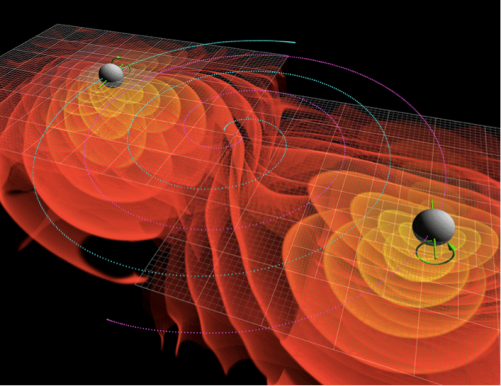As a chemistry graduate student I don’t normally take classes outside of the chemistry building, but this semester I happened to have an optics course in the physics department. So a few months ago when scientists at the Advanced Laser Interferometer Gravitational-Wave Observatory (LIGO for short) found gravitational waves,1 I got an inside look at just how excited physicists can get! Everyone in the department was walking around with smiles on their faces and talking animatedly to each other in the hallways. They were like kids at Christmas. Well, like kids who know a lot of math and like to talk about physics.

Why were they so excited? The team at LIGO had measured two black holes colliding and releasing waves of gravity at the other side of the universe! Predictions about the fundamental laws of the universe that Einstein and other scientists had made years ago were confirmed, including the general theory of relativity. All that excitement was over a really small signal, and it got me thinking: how do we measure something that tiny, and when we do, how do we know it’s what we’re looking for?
How small are we talking about here? The signal the LIGO team was looking for was only 10-21 m big. That’s a lot like trying to find a blueberry that’s floating somewhere on the earth’s oceans!* So how did scientists even manage to make a measurement like that?
First things first, you want your ocean to be calm and your blueberry brightly colored. For LIGO, it took years to calm down their “ocean” of background noise until it was so flat that they could see their blueberry. Then they looked at two of the “brightest” gravity spots in the universe: a pair of black holes. Black holes stand out because they have the strongest gravitational pull that we know of. Imagine if you wanted to see waves in a pool — you’d want to throw in a big heavy rock to get the most obvious results. The same thing applies at a cosmic scale.

Here at the CSN we’re lucky compared to LIGO. Even though we study nanoparticles that are a thousand times thinner than a human hair, that means our measurements are more like trying to find a blueberry on a pond. Our “ocean” is all the biology in little water fleas or zebra fish, and we have tools to make our nanoparticles appear brighter: some show up dark against the light water flea, others glow when we shine light on them. (You can read more about how we take pictures of nanoparticles in this recent blog post.) Scientists finding gravitational waves can’t use exactly the same techniques we do, but LIGO does average over thousands of measurements to help get a clearer signal.
But what happens after we spot the thing we’re looking for? Are we done? Well, not quite. The next important question to ask is: are we sure that’s a blueberry? Could it just be a wad of gum or something else? You might solve this problem by examining the object, and then turning to your friend and asking, “Hey, do you see that thing out there? What do you think it is?” And if they answer, “Why, yes, it looks like a blueberry!” then you know you might be right.

Well, scientists from all fields do the same thing! At the CSN, we work at different universities, and each group sends nanoparticles around to be tested by many different people in many different ways. After all this testing, we can be a lot more confident that our results are telling us something true. Similarly, LIGO has two big instruments across the country from each other to make sure that what they see isn’t caused by someone dropping a pencil or getting dust in the instrument. And all that careful planning paid off; when they saw a signal, it was on both instruments!
In measuring everything from nanoparticles to cosmic phenomena, all scientists have similar methods when we collect data. We all try to get more signal and less noise, and we all look for repeatable measurements. Whether it’s in the CSN, LIGO, or even finding a blueberry, the same scientific methods can help find the answers!
FOOTNOTE
* Let’s do the calculation: The surface of earth’s oceans is about 139.4 million square miles (3.6×1014 square meters), and a blueberry is about a square centimeter. So 10-4 m2 /1014 m2 = 10-18 is almost there — the actual number of 10-21 would be more like finding a single grain of sand in the oceans!
EDUCATIONAL RESOURCES
- LIGO classroom activities (including star chart, building a spectroscope, etc.)
REFERENCES
- Svitil et al. Gravitational Waves Detected 100 Years After Einstein’s Prediction [press release] 2016. Retrieved from https://www.ligo.caltech.edu/news/ligo20160211
